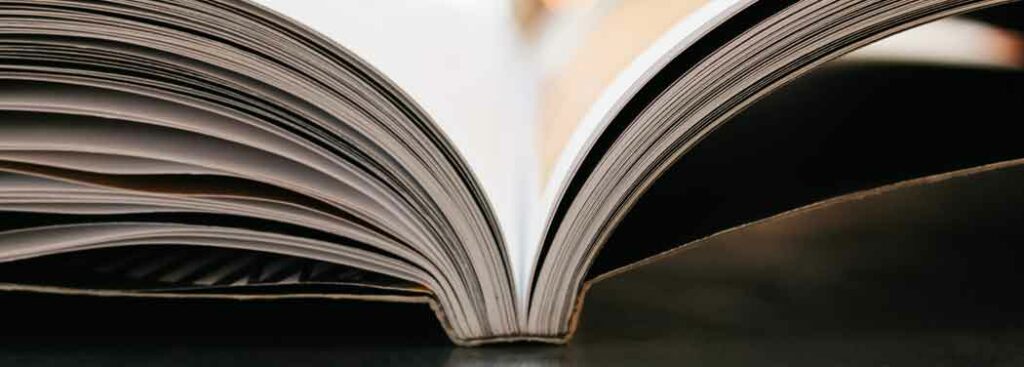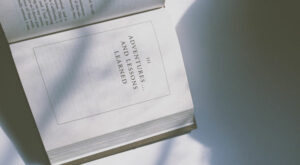Learn the Ultimate Book Format Guidelines for Nonfiction Authors

As a business owner or a professional, learning how to format a book the right way is absolutely essential. A well written and laid out nonfiction book can turn you overnight into an expert in your field. Your book may lead to media outlets seeking you out for your expert opinion, resulting in free media exposure.
It may also land on the desks of decision makers that may select your services over a competitor’s simply because you’ve written a book and they haven’t. A book may open doors for paid speaking engagements since event managers tend to be biased towards authors.
And finally, a book may become a lead generator by projecting expertise and trustworthiness to potential clients.
But none of the above will come to pass if your book isn’t designed professionally. This is one of two areas where you cannot afford to cut corners by giving the job to a family member or using the DIY approach. The other area is editing, which is outside the scope of this article (learn here how to hire a professional editor).
So, why then write a article about how to format a book? Because it’s important that you become familiar with the different elements that your book designer will work with, especially when many of the design decisions will be made in consultation with you.
Here are the key elements that are part of professional book design.
Elements of Book Formatting
A quality nonfiction book has three main components: the front matter, the main body and the back matter. Each has a specific function in the book and in some cases they contain elements that are mandatory in the book trade. If these sections are missing, you won’t be able to distribute your book through mainstream channels.
Let’s get into the details.
Front Matter
The front matter in a book will have some or all of the following sections:
- Testimonials (Optional): Nonfiction books typically begin with two or more pages of testimonials, since social proof is highly regarded by readers. You’ll have to solicit testimonials from advance readers prior to publication. Include in your testimonials colleagues and business associates, members of your target audience and, if you can, recognized authorities in your field.
- Title Page (Mandatory): This page contains your title, subtitle and the author’s name.
- Copyright Page (Mandatory): This page appears on the back of the title page and contains the copyright statement showing the year of publication; your publisher’s address, a P.O. Box if you’re self-published and don’t want to disclose your physical address or your business address; library cataloguing information; and any legal disclaimers.
- Epigraph (Optional): This page can be used to show a quotation or inspirational statement that adds context to your book, or simply a favorite quote that you’d like to include in your book.
- Dedication (Optional): This page acknowledges a person or an entity that you want to dedicate your book to.
- Table of Contents (Highly recommended): This page or pages shows a listing of your contents and is usually auto-generated by the software used by your book designer.
- Foreword (Optional): This is an introduction to your book that is typical written by an authority in your field, where they can sing your praises or the praises of your book.
- Preface (Optional): This is a section written by you where you can tell your readers about the genesis for your book, something about yourself that is relevant to them and, if this is a second or subsequent edition of your book, a mention of the changes that were made in relation to the previous edition.
- Acknowledgments (Optional): Here you may want to acknowledge anyone who helped you in the creation of your book, including associates, your editor, your book designer, any other professional that you’ve hired to produce and promote your book, your family and anyone else of relevance to your book project.
- Introduction (Highly recommended): Your book’s introduction will be the sales letter for your book. This is typically the third area that readers will seek before deciding to purchase your book. First they’ll look at your book cover, then they’ll quickly browse your table of contents and finally they’ll read your introduction.
Body
Now, let’s get into the technical aspects of your book. The body of the book is where your entire manuscript resides. In order to make your book appealing to your readers, there are a number of formatting elements that your designer will play with, as follows:
Trim Size

The first thing your designer will choose is your trim size or book size. For nonfiction books, there are three common trim sizes that the vast majority of books are printed on:
- 5 x 8 inches
- 5 x 8.5 inches
- 6 x 9 inches
Custom trim sizes are possible but usually authors shy away from them due to their high cost.
Fonts
There are thousands of fonts to choose from in the book design market. Font choice is a highly complex visual exercise and you should trust your professional book designer to make the right decision for you.
Choosing the right font is more art than science and it comes down to years of experience in book design. The right font will make your book look great and the wrong font will give your reader a headache – but you might not be able to tell which is which if you were to look at them separately.
Drop Caps
This is a font treatment that is widely used in nonfiction books. A drop cap is applied to the first letter of the first word of each chapter, and it’s created by making that letter outsized in comparison to the font size applied to the rest of the book. A drop cap has the height of several lines of text in your book.
Paragraphs
There are two main styles for nonfiction paragraphs. The traditional style is borrowed from fiction books and it consists of indenting the first line of each paragraph by approximately 0.25 inches.
This is done in order to show the reader where one paragraph ends and the other begins. The exceptions are the first paragraph of a chapter (since it’ll likely use a drop cap) and the first paragraph after a title heading (e.g. sub-chapter headings, sub-subchapter headings, etc.). In this case, the first lines in those paragraphs are not indented.
The second common style for nonfiction books is to not indent the first line of paragraphs and instead add a space between paragraphs. The reasoning is that nonfiction books contain a lot of information to be processed by the reader and adding spacing between paragraphs allows readers to take a breather as they think through the content they just read.
Ornamental Graphics and Breakout Boxes
Often nonfiction books are so jam-packed with information that needs to be thought through by readers that authors like to place a small ornamental graphic or a pictogram as a separator between blocks of text in order to provide readers with a visual pause.
Another commonly used technique is to add breakout boxes with larger text to highlight a key takeaway from the section that precedes it.
Chapter Page

The first page of each chapter typically gets a different treatment than the other pages. Often times the text begins a third down the page and sometimes half way down.
The font used for the chapter title is typically much larger than the body font, and sometimes it’ll include a graphic element that adds context to the chapter or a graphic element that appears on the book cover.
Header & Footer
The header is usually used as a navigational tool for the reader. It typically shows your book title on the left hand page and the title of the current chapter on the right hand page.
Headers also include the page numbers, with one key exception – chapter pages usually include the page number in the footer instead and in some books they skip the page number altogether.
Back Matter
The back matter in a nonfiction book will have some or all of the following sections:
- Afterword (Optional): This is a section that is sometimes used as a counterpoint for the introduction to allow authors to leave readers with a final thought.
- Appendices (Optional): This is an area where you can add supporting information that you feel is necessary but doesn’t flow in the body of your book.
- Glossary (Optional): Some books need to use very specific nomenclature that readers may not be familiar with. The glossary will list this information alphabetically with an explanation for each term.
- Indexes (Optional): If your book has an index or several indexes, say one for words, one for images, one for exercises, etc., they’ll be located right after the above three sections if present or, in their absence, immediately after the last page of the body.
- References or Bibliography (Optional): This section contains a list of external publications that you’ve referenced throughout your book.
- About the Author (Highly Recommended): This final section is for you to provide your readers with a short bio, show them other books you might have published before, announce an upcoming book and to show them how to contact you should they want to reach out.
Gutters & Margins

Outside of the body, front and back matter, there are a couple of final design elements that relate to the overall design of the book. The first one is gutters and margins.
A gutter is the space that must be left blank between the binding edge of your book and the body text. This space is chosen by your designer based on how thick your book is.
If you have a large number of pages in relation to your trim size, they’ll need a more generous gutter so that when readers open the book in the middle they’re able to comfortably read the text closest to the binding (the glue in the spine will keep the pages from separating). If your gutter is too small, readers will have difficulty reading your book near the binding.
Your book’s margins are used to create a balance between white space and text so that your book doesn’t feel “cluttered.” The margin is also the white space where your reader’s fingers will rest when holding your book, so you don’t want them to be too thin.
Space
Finally, your book designer will make use of positive and negative spaces to create an overall aesthetic for your book. Positive space is any area that contains text or any graphic element and negative space is any white space surrounding the positive space.
The white space in the margins is part of this balance, so is the space between images and text, the space above and below section titles, the white space in chapter pages, and the space above and below breakout boxes.
Next Steps
Now you have a good idea about the different design elements that your book designer will be using to create a nonfiction book that a) appeals to your audience, b) is relaxing to read and c) is pleasing to the senses.
If you’re currently working on your manuscript, there are formatting aspects that you need to be aware of before you hand it over to your editor. To learn more, I’ve created a companion article: How to Format a Manuscript Like a Pro (A Guide for Nonfiction Writers).
Good luck!
If you enjoyed this article and are in the process of writing, designing or publishing a nonfiction book, be sure to check out my free nonfiction success guide, drawn from years of experience editing books for bestselling authors (including a New York Times bestseller) and ghostwriting for CEOs and politicians. Simply click here to get instant access.
Ben
Leave me a comment below if you have any questions or a specific need that I can help you address – I operate an author services firm that specializes in helping entrepreneurs, professionals and business owners who want to publish books as a calling card for prospects, to establish their status as an expert or to just to generate additional leads for their businesses.
Here are some related articles I highly recommend:
How to Become a Great Book Writer in Business Nonfiction
The 7 Key Rules for Writers of Outstanding Nonfiction Books
The 10 Must-Have Writing Skills for Nonfiction Authors
How to Write a Compelling Book in 12 Steps: A Must-Read Guide for Nonfiction Authors
 Bennett R. Coles is an award-winning author of six books published through Harper Collins (New York) and Titan Publishing Group (London). He is also the publisher at Promontory Press, editor for multiple bestselling authors (including a NY Times bestseller), ghostwriter for CEOs and politicians and the founder of Cascadia Author Services, a boutique full-service firm that specializes in premium author services specifically designed for busy professionals. Our end-to-end services include writer coaching, ghostwriting, editing, proofing, cover design, book layout, eBook production, marketing, printing and distribution.
Bennett R. Coles is an award-winning author of six books published through Harper Collins (New York) and Titan Publishing Group (London). He is also the publisher at Promontory Press, editor for multiple bestselling authors (including a NY Times bestseller), ghostwriter for CEOs and politicians and the founder of Cascadia Author Services, a boutique full-service firm that specializes in premium author services specifically designed for busy professionals. Our end-to-end services include writer coaching, ghostwriting, editing, proofing, cover design, book layout, eBook production, marketing, printing and distribution.
4 responses to “Learn the Ultimate Book Format Guidelines for Nonfiction Authors”
-

This is the most concise summary I’ve seen online. Kudos, Bennett
-

You’re more than welcome, Jim!
-
-
Very informative and helpful. Thank You.
-

Thank you for all the info. A big help to first time authors…







Leave a Reply